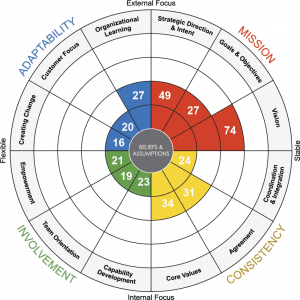
BCS Financial: Leading a Dynamic Cultural Evolution from Within
BCS Financial Corporation seemed to be on top of their game. Built on 60 years of success, they’ve enjoyed underwriting profits for the past 20 years and an A.M. Best Rating of “Excellent.” They seemed to have a solid foundation, so why change? “Why change?” asks Scott Beacham, President and CEO of BCS Financial, “Because our business sector is changing. As a multi-line insurance company licensed to do business across the United States, we’re operating in one of the most dynamic industries, in one of the most dynamic times in history.”
As Beacham joined the organization, healthcare reform was on the brink of becoming a reality and the landscape in which they were operating was about to change dramatically.
BCS is owned by all Blue Cross and Blue Shield primary licensee companies. Collectively, these companies are both BCS’ governing body and their clients. Therefore, as Blue Cross and Blue Shield organizations change, so must BCS. The leaders at BCS recognized early in their evolution that they had to change. And change they did!
This is the story of BCS and the five critical success factors that made their change possible: Leadership, Core Values, Quality of Process, Actions Leading Plans, and Organic Ownership. Their story is focused on strong leadership from above and empowerment from below. In the words of the people of BCS, “Whose story is it? Our story.”
Critical Success Factor #1: Leadership
“You can’t wish change; you have to make it happen,” states Beacham. “It’s about the hearts of the people who have to make the change. Very smart people can come up with business strategy, but it’s through a truly dedicated team of people that you create positive change from within.” BCS had a rock-solid platform. However, it was just that: a platform, a plateau with a proven record.
They needed to progress. In order to find the growth they were looking for, they needed to bring together their strategic platform with their culture transformation process. The success of the past 60 years didn’t make any difference in the vastly changing healthcare world. It was time to evolve. BCS leaders committed themselves to blending their strategic and culture goals for the good of their organization and its people.
Beacham often says, “If you have their heart, I guarantee you’ll have their mind.” As a leader, Beacham is very concerned about engaging the hearts of his people. “Engaging people is going out and having the courage to ask them, ‘How are we doing?'” Beacham takes his daily “walks around the block” as he calls them. He knows each employee by name, engages them in conversation, and regularly asks them, “How are we doing?” He encourages everyone in leadership roles to do the same. Beacham admits that it is hard to hear feedback at times, but the leadership of BCS has never wavered in their energy or their commitment; he makes sure of that.
Best Practices in Leadership
Barbara Osterman, President of Human Solutions, LLC, is a partner with BCS and offered coaching and feedback to the organization as part of their process. She offers some best practice advice in this first Leadership Chapter:
One of the important things that BCS did was to shift focus from ‘getting work done,’ to creating an environment for people to do great work. It’s a subtle shift, but very different. Second, senior leaders were whole-heartedly committed to this process. If the people in the organization see any wavering at the top, that’s an indication or an excuse for them to maintain the status quo.”
~Barb Osterman
One of the important things that BCS did was to shift focus from ‘getting work done,’ to creating an environment for people to do great work. It’s a subtle shift, but very different. Second, senior leaders were whole-heartedly committed to this process. If the people in the organization see any wavering at the top, that’s an indication or an excuse for them to maintain the status quo.”
~Barb Osterman
Year 1

Year 2

Critical Success Factor #2: Core Values
Mike Kichka is the Director of System Integration and the leader of the Culture Team at BCS. In his words, “This initiative is all about our ‘heart’ and strengthening our core values. We are confident that with the right people with the right attitude, we will be successful in changing our culture.”
To begin their Dynamic Evolution, BCS created five work groups called the Spheres of Influence: Growth, Service, Finance, Communication, and Creativity. The Spheres are made up of cross-functional groups of employees. Each Sphere’s mission is to create strategic and tactical imperatives to drive profitability and performance, improve vertical and horizontal communication, and enhance enterprise-wide teamwork and creative thinking. Shortly after creating the Spheres, BCS established a Culture Team with its own strategic and tactical imperatives. The Culture Team’s mission is to motivate and inspire employees and bring meaning to BCS’ core values. The volunteer-based Culture Team started with four members and has since grown to 12.
One of the mantras you’ll hear and see walking around the BCS office is “212 Everyday,” which started with the Simple Truths book 212·: the extra degree by Sam Parker and Mac Anderson.
The idea is that at 211 degrees, water is hot. At 212 degrees, it boils. Boiling water produces steam. And steam is powerful enough to move locomotives. By applying an extra degree of effort, amazing things can happen. Hence, BCS’ “212 Everyday” initiative was born to motivate employees and elevate the passion within the workplace. They branded the initiative, developed a logo and theme to identify the initiative, reinforced the message, and supported its long-term objective.
Additionally, BCS developed 12 values called Key Positive Forces (KPFs) serving as guiding principles for business operations. “These KPFs are the cornerstones of the initiative and vital to improving our ability to manage our day-to-day operations,” says Kichka. “The most crucial aspects of this initiative are the attitude and belief that we can change, and the commitment and perseverance to make it happen. Scott clearly communicated that all of these efforts are important. However, the employees will know BCS has changed when they experience the change on a daily basis.
Core values are about a state of being, an aspirational state. The first thing to do is to define your core values. Not in a senior executive meeting, but in your organization. When we look at BCS’ 12 core values, we each have a different idea of what those mean. Groups within BCS developed statements to go along with each of their core values so that people within the organization know what it means to demonstrate “respect” and live it. BCS found a way to support these in everything that they do.”
~ Barb Osterman
Core values are about a state of being, an aspirational state. The first thing to do is to define your core values. Not in a senior executive meeting, but in your organization. When we look at BCS’ 12 core values, we each have a different idea of what those mean. Groups within BCS developed statements to go along with each of their core values so that people within the organization know what it means to demonstrate “respect” and live it. BCS found a way to support these in everything that they do.”
~ Barb Osterman
Spheres of Influence
With the creation of the Spheres: Growth, Service, Finance, Communication, and Creativity, and the Culture Team, BCS created cross-functional teams that were accountable to the strategic goals of the company. They were expected to create goals and objectives to drive profitability and performance within the organization. This gave employees a line of sight not only to their own functional departmental goals but also to the organization’s goals, increasing communication, creativity and teamwork within BCS.

Key Positive Forces: Core Values
When BCS started creating their Key Positive Forces or their core values, they started with 36 words that meant something to them. Through many meetings and conversations, they pared them down to these 12 key words. Each of these words has a specific meaning; they are more than just words on a plaque on the wall. The employees of BCS define what each of these values means to them specifically. If you walk through their halls and ask any employee what “Perseverance” or “Belief” means they will give a consistent answer. Almost every workspace in BCS has some form of the Key Positive Forces, whether it is a poster such as this one or the compass. Their values are as important to them as their strategic plan, their profit margin or their sales projections.
Critical Success Factor #3: Quality of Process
Greg Petit is the Manager of Marketing Services at BCS. Petit has been with the organization for 20 years and witnessed the amazing transformation at BCS firsthand. Petit, along with many others who have been with the company for over 20 years, established his roots while the company was structured in a very traditional hierarchical management style, one that was successful for 60 years. “Many of us grew up in an environment of ‘this is not how we’ve done this before.’ We went from quietly minding our own business to something radically different,” comments Petit.
Leadership began collaborating with employees for the first time: respecting their ideas and giving them the room to innovate. This was very new for BCS employees. The walls became permeable and employees were allowed to lead in the process. Petit recalls some backroom discussions during this time: “Do you think these Sphere groups are going to last much longer?” Soon they saw that the new that the new way of doing things was there to stay because it was integral to the corporate vision, mission, and the balanced scorecard.
“We also saw that the Spheres were being staffed by crossdepartmental representatives and found ourselves working together and listening to each other, and we were actually enjoying the process.” The people at BCS were engaged and accountable for their actions in new ways. “It was very different from the old structure of isolation and staying out of trouble,” recalls Petit. “We had a brand new attitude. Now, it was about trying to add value and provide excellent service for each other.”
Quality of process became the key to everything. Employees had to trust the quality of the process because the learning that was occurring was more important than a preconceived outcome. Petit also heads up the Creativity Sphere. This group challenged itself to develop a decision tree. On the surface, a decision tree sounds very business-like. But as they worked through the process, their goal became clear: “We came up with an idea notation process providing all employees an analysis tool guiding them to implement their ideas autonomously if possible or collaboratively if necessary.”
The key in quality of process is to invite employees into the challenges that you face and then to trust them. You hear the word ‘organic’ a lot in the hallways of BCS. At first, the employees of BCS were waiting for this to go away. Leadership had to make it real for them and engaging them in the process was the way to do it. They couldn’t sacrifice the quality of process because they had a date for an outcome. Much of what we had planned in the strategic planning process didn’t happen when it was planned; it happened when it was ready to emerge. It didn’t mean that we let those goals go, but were asked people to learn while they were working. This was new for them and learning only happens when they are engaged and allow those conversations to take place”
~ Barb Osterman
The key in quality of process is to invite employees into the challenges that you face and then to trust them. You hear the word ‘organic’ a lot in the hallways of BCS. At first, the employees of BCS were waiting for this to go away. Leadership had to make it real for them and engaging them in the process was the way to do it. They couldn’t sacrifice the quality of process because they had a date for an outcome. Much of what we had planned in the strategic planning process didn’t happen when it was planned; it happened when it was ready to emerge. It didn’t mean that we let those goals go, but were asked people to learn while they were working. This was new for them and learning only happens when they are engaged and allow those conversations to take place”
~ Barb Osterman
Letting Quality of Process Take the Lead
By trusting and engaging in the quality of process they were undertaking, instead of focusing on the outcome, the employees of BCS embraced their empowerment. They were able to create a decision tree that ultimately led to 15 product, practice, and procedural innovations that saved the organization both time and money.

Critical Success Factor #4: Actions Leading to Plans
In the past, BCS made their strategic plans primarily in their functional groups: marketing, financial, and information technology, etc. With the creation of the Spheres: Growth, Service, Finance, Communication, and Creativity, along with the Culture Team, they were able to create cross-functional teams to think in a broader context of the organization. Jim Drew, Assistant Vice President of Communication, comments, “As a community, we were able to shift our thinking so that we didn’t just have functional goals in mind, but also the corporate goals represented by our Spheres. This allowed us to recalibrate how we worked as a group and realign into cross-functional teams to create our strategic map framework.” Through that process, they created their strategic map, containing both strategic and cultural goals. This one page document took about a year to produce. Content wise, it is not long but very well thought out by the entire organization. Everyone, leaders and employees alike, now buy into it.
In many ways, BCS’ actions lead their plans. Because they had gone through this process of reflection, they were able to transition their strategic framework into the organization’s first balanced scorecard. The scorecard became a natural part of the organization on the strategic side.
On the cultural side, BCS had taken their first Denison Organizational Culture Survey in 2009, about six months into their transformation process. They renamed the Denison Organizational Culture Survey the BCS Pulse because first Denison Organizational Culture Survey in 2009, about six months into their transformation process. They renamed the Denison Organizational Culture Survey the BCS Pulse because it measures the heart of the organization.
Based on the Pulse results, the Culture Team developed a 50-page analysis document, including survey results and focus group feedback. Feedback was collected through a series of safe harbor discussions, lunch and learns, and other sessions specifically designed so that people could feel free to collaborate, share their feelings, and discuss the results in a very transparent manner. Drew states,”Going through this process, I think one of the biggest successes we achieved was being able to answer two critical questions very effectively: Whose plan is this? Ours. Who created it? We did. If we couldn’t have answered those two questions, I can’t imagine how we could have achieved what we did in the first year and what I whole-heartedly believe we’ll achieve for years to come.”
At BCS, this is where the employees started to understand that the work they were doing in the Sphere Teams was intersecting with the strategic plans. Action plans are about execution and accountability. To be successful, they need to come from the people who are doing them, the people who know best what needs to be done, so you are able to hold those people accountable. The BCS scorecard focuses on Growth, Service, and Finance, which you would see on almost any business scorecard, but also Communication and creativity. In this way, BCS weaved together the business and the cultural outcomes to achieve business results.”
~ Barb Osterman
At BCS, this is where the employees started to understand that the work they were doing in the Sphere Teams was intersecting with the strategic plans. Action plans are about execution and accountability. To be successful, they need to come from the people who are doing them, the people who know best what needs to be done, so you are able to hold those people accountable. The BCS scorecard focuses on Growth, Service, and Finance, which you would see on almost any business scorecard, but also Communication and creativity. In this way, BCS weaved together the business and the cultural outcomes to achieve business results.”
~ Barb Osterman
Critical Success Factor #5: Organic Ownership
Throughout their Dynamic Evolution, employee empowerment was a critical component. The employees owned the process. Many organizations faced with issues of empowerment wonder where to start and how to give their employees the empowerment for which they are looking. Trust is always a critical factor in issues of engagement.
Cindy Jenkins, Senior Accountant and member of the Culture Team at BCS, talks about how Beacham empowered employees, “The employees of BCS became empowered the day that Scott asked us one simple but courageous question, ‘How are we doing?’ He wanted honest results on the Pulse, whether it was good, bad, or ugly. This gave us an opportunity to have a voice and made us feel like our opinion mattered. After we received the results, Scott challenged us with another question, ‘How can we do it better?’”
Along with empowerment came accountability for actions. In his own leadership role, Beacham stressed that the cultural change was owned by the employees, giving them the chance to be leaders. As a result, employees were empowered and encouraged to take ownership and be accountable for what they did. On an individual level, the action and operational plans that were derived from the BCS Pulse results and their balanced scorecard were incorporated into employees’ personal work goals.
This helped to show employees how they fit into the bigger picture, reinforcing their values, their “212 Everyday,” and the fact that they can make a difference in their organization.
Teamwork and communication were also enhanced through the Sphere Teams. Because the teams consisted of employees from different departments, it gave each team a broader lens to look through when implementing the operational plan. This also created a forum that has opened up communication across departments.Employees better understood the upstream and downstream effects of their actions and found ways to streamline their processes and help each other. Many Spheres have sought feedback outside of the team to get ideas and provide feedback. This stimulated creativity, promoted the exchange of ideas, and provided a healthier atmosphere for teamwork. This stimulated creativity, promoted the exchange of of ideas, and provided a healthier atmosphere for teamwork.
Finally, recognition has been a key factor to sustain momentum. Recognition has taken many inspirational and motivational forms including posters, awards, or simply saying thank you and sharing in team accomplishments and milestones.
People have run through all five of these success factors: engaging them, allowing them to make a difference, hearing their voices, their ideas, and truly listening to what they have to add to the business process. It’s about leaders creating the environment for people to excel. Many companies say their people are their greatest asset; BCS lives it.”
~ Barb Osterman
People have run through all five of these success factors: engaging them, allowing them to make a difference, hearing their voices, their ideas, and truly listening to what they have to add to the business process. It’s about leaders creating the environment for people to excel. Many companies say their people are their greatest asset; BCS lives it.”
~ Barb Osterman
Whose Plan? Our Plan!
The BCS cultural transformation was organically achieved through a quality of process, rooted in core values, that empowered leaders from within to actively create the organization’s strategic plan. Beacham has been highlighted over and over again by his employees as a great leader, but if you ask him, he gives credit to the BCS team. Beacham says, “If you walk through the hallways of BCS and ask any of the employees, ‘Whose plan is this?’ They’ll say: ‘It’s our plan.’ ‘Who has to execute this plan?’ ‘We do!’ The sense of pride that our people have in this will allow us to continue to perform now and into the future.”
